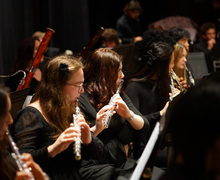‘The Zone of Interest’ employs a chilling, unconventional approach to the Holocaust genre
Daily Orange | File Illustration
‘The Zone of Interest,’ a film by Jonathan Glazer is a twist on historical dramas set during the Holocaust. Focusing on the perpetrators rather than the victims, the film creates a chilling atmosphere.
Get the latest Syracuse news delivered right to your inbox.
Subscribe to our newsletter here.
What is the darkest form of evil? Writer and director Jonathan Glazer makes an argument in “The Zone of Interest” that it’s perpetrators living in blissful ignorance of their horrific crimes.
The film follows a fictionalized version of Nazi commandant Rudolf Höss (Christian Friedel) and his family as they to build an idealistic and happy life at their home that sits right next to the Auschwitz concentration camp: the titular “zone of interest.” Glazer adapted the film from a 2014 novel of the same name by Martin Amis. Glazer took some liberties from the original, such as changing the names of characters into real-life historical figures like Höss.
On its surface, the movie seems like a historical domestic drama about a family trying to stick together. The Höss family may act like nothing is happening, but Glazer won’t let us forget. The director uses haunting sound design, beautiful color schemes and carefully-crafted backgrounds to imply the despicable events that took place at Auschwitz.
Previous films about the Holocaust have unapologetically shown the brutality of the genocide. Steven Spielberg displayed scenes of Jewish people being murdered in “Schindler’s List.” Claude Lanzmann presents accounts of survivors and perpetrators of the Holocaust in his nine-hour documentary “Shoah,” while taking the audience to concentration camps all across Poland.
But Glazer never lets us see the violence up close. In fact, we rarely get to see the Jewish prisoners, only showing those in the camps through obscured views. Glazer takes this even further by barely featuring typical Nazi iconography like the swastika. Höss also only occasionally gets seen in his SS outfit. Höss also views the “Heil Hitler” salute as a formality akin to being part of a corporation by mockingly saying the phrase at phone calls.
The German characters never really wear their hate-filled hearts out on their sleeves. Their antisemitism reveals itself through glances toward the Jewish servants who are assigned to work in the Höss household. A portion of the film focuses on Höss’ wife, Hedwig (Sandra Hüller), interacting with the servants. Whenever Hedwig talked to fellow Germans, she would give distinct glares to the servants, subtly revealing her distrust and resentment.
Most of the time, though, Hedwig seems like a housewife striving for a domestic perfection she will never attain. She tries to manage her kids and build a beautiful garden that gets compliments from other housewives.
In a homemaking sense, her efforts aren’t in vain. The garden has beautiful plants and trees, with the green color serving an intentionally distasteful contrast to the horrors that are happening next door.
The opening shot of the movie is a beautiful glimpse of the Höss family having a picnic and swimming at the nearby river. Glazer purposely crafts beautiful-looking shots throughout the whole movie to show how the Hösses have achieved beauty and perfection in their own eyes.
If Glazer just stopped there, this would be an intriguing and problematic look at a high-ranking Nazi official’s family. Much of the time, Glazer firmly puts us in position with the Höss family as he and cinematographer Łukasz Żal use static long takes to firmly entrench the viewer in the seemingly mundane life on the surface.
But the director makes the audience grapple with the fact that Höss and his compatriots committed these atrocities. The film’s typically quiet moments get replaced by grotesque sounds and a score by songwriter and composer Mica Levi that would be more fitted for a horror film.
Again, Glazer never shows us specific moments of brutality. He doesn’t seem interested in overtly and distastefully portraying trauma that’s been shown time and time again. Instead, he presents shots of Höss looking at the violence with resignation before the film cuts to white while the audience still hears the terror. Midway through the film, there’s a sudden cut to a rose that eventually fills the screen a blood red, accompanied by more terrifying music.
All of this is an effort by the director to make us well aware that the characters will just ignore all the unsettling sounds that they hear. Hedwig even puts plants on the wall that separates her garden and the death camp. While the characters will not acknowledge or question the circumstances, Glazer makes it crystal clear that the Höss’ way of life produces death.
He continues with a bone-chilling ending that offers the audience no peaceful resolution. Glazer acknowledges the Holocaust continued even after this specific story ended. There wasn’t sentimentality like in “Schindler’s List” or glorious revenge like in Quentin Tarantino’s “Inglourious Basterds.”
“The Zone of Interest” reflects that the Germans dehumanized and committed a genocide against the Jewish people and other minority groups, but at the same time willfully ignored the acts they committed. And perhaps, Glazer suggests that, as a society, we still don’t fully understand that humans are still capable of killing with ignorance. The cold indifference creates the purest form of evil.
Published on October 17, 2023 at 10:18 pm
Contact Henry: henrywobrien1123@gmail.com






